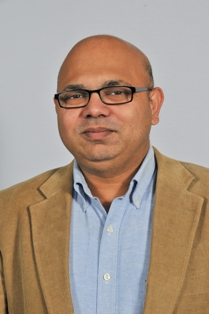Harvard Business Review publishes business professors' research
Sheryl Sandberg, chief operating officer of Facebook, has recently brought into the spotlight that even today women are paid less on average than men in the workplace. Three Wayne State University business professors published a two-year long investigation into this phenomenon of gender-based compensation gap in the C-suite.
"Ending the Wage Gap," co-authored by Professors Sudip Datta, Mai Iskandar-Datta and Abhijit Guha, was published in the May 2013 issue of the Harvard Business Review. Their research found a 4.5-5 percent wage gap for female chief financial officers (CFOs) two years after hiring. The authors examined hand-collected data from 1994 to 2007. The 1,598 CFOs studied were controlled for similar educational background and industry. Only 10 percent of the CFOs studied were women. The co-authors suggest ways for female CFOs to address this issue and provide practical advice for employers.
 “The question of gender-based wage gap has been at the forefront [of the conversation] for several decades,” said Datta, T. Norris Hitchman Endowed Chair, professor of finance and interim chair for the business school’s finance department.
“The question of gender-based wage gap has been at the forefront [of the conversation] for several decades,” said Datta, T. Norris Hitchman Endowed Chair, professor of finance and interim chair for the business school’s finance department.
According to Datta, prior research on the subject of pay parities between males and females focused on the lower levels of corporations; however, even at the C-suite wage gaps exist.
“Women who are at the upper echelons of the corporation who are more informed, better educated and more driven with leadership qualities also experience this problem,” Datta said. “If they cannot reduce the gap, then how can women at lower levels get parity?”
The innovation of this study is that it looks at the compensation at different points in time. Most previous studies do not distinguish between compensation at the point of hiring and at later points in time. However, given that most executives are more likely to engage in negotiations when hired, the pattern of compensation may differ depending on when it is measured.
According to the study, at the time of hiring women get a slightly higher salary offer; however, in two years time the women’s salaries fall behind the men’s salaries.
“Our study is pointing out the pattern for human resource departments, so they can be proactive,” Datta said. This is important for boards of directors because they want to keep talented individuals regardless of their gender.”
 “It is a travesty that even women executives at the highest levels are sometimes not rewarded in an equal manner. Keep in mind that we control for firm performance. So even after we control for performance, female CFOs are not paid similarly. It seems that the perception out there is that female executives will settle for less,” said Iskandar-Datta, professor of finance, Board of Visitors fellow and dean's research chair.
“It is a travesty that even women executives at the highest levels are sometimes not rewarded in an equal manner. Keep in mind that we control for firm performance. So even after we control for performance, female CFOs are not paid similarly. It seems that the perception out there is that female executives will settle for less,” said Iskandar-Datta, professor of finance, Board of Visitors fellow and dean's research chair.
But that does not have to be the case. The authors suggest four key things women can do to rectify the situation and ensure equal pay: they need to show their willingness to move, they should also compete within the firm, get a contract clause at time of hiring pegging their future pay to that offered at comparable firms, and be willing to negotiate salary raises in years after hiring.
“To reduce the compensation gap, we advise female executives to be more aggressive with their annual negotiation for performance-based compensation,” Iskandar-Datta said.
“When women are looking for jobs they negotiate just as hard as the next executive, but after that, they settle for whatever raises they are given,” Iskandar-Datta said. “If someone is underpaid, they have to step up and discuss it, that’s what the research says.”
 “The [woman] CFO has to stop worrying about being liked,” said Guha, assistant professor of marketing. Guha’s main focus for the article was human behavior and academic prescriptions for what women should do.
“The [woman] CFO has to stop worrying about being liked,” said Guha, assistant professor of marketing. Guha’s main focus for the article was human behavior and academic prescriptions for what women should do.
Guha says this research is important because it is relevant and useful to managers and workers alike.
The co-authors began this research two years ago and are working on a second study focusing on how women approach raises.
Read an online version of the article here.



